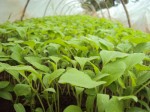Hardening off seedlings is the secret that commercial growers use for better transplants
Plants must be acclimatized to the shock and stress of transplanting into the greenhouse by slowly removing the optimum growing conditions of the nursery. This is accomplished by a process known as “hardening-off”. To harden off seedlings, commercial growers
- reduce irrigation frequency
- lower temperatures and
- stop applying any fertilizers to the seedlings.
Care must be taken to not “over harden” young transplants. With cool-season crops exposed to very low temperatures, bolting (in biennials such as cabbage) or buttoning (in broccoli or cauliflower) can be induced. Warm-season crops generally are hardened at temperatures higher than those of cool-season crops. Cold temperatures set back warm-season crops and can induce disorders such as cat face in tomatoes.
If using a shade cloth structure the climate of the growing area cannot be altered that much. If mini-tunnels were used during the first weeks of the seedlings development, that must be removed. Another problem is when more than one stage of growth is present in the growing area. In this situation mini-tunnels are ideal.
To harden off seedlings, temperatures are kept between 10 and 15°C for cool season crops and sub-tropical crops. The minimum temperature is kept at 13°C for warm season crops.
Vegetable crops differ in their ease of transplanting. The degree of difficulty in transplanting follows:
- Easy to transplant: efficient in water absorption and rapid formation of new roots:
- beets
- broccoli
- cabbage
- greens
- lettuce and
- tomatoes.
- Moderate: young plants do not absorb water as efficiently, but new roots form quickly:
- cauliflower
- eggplant
- leeks
- onion and
- pepper.
- Difficult to transplant: root system is easily injured during transplanting; plants cannot be stored easily, especially if they become too large:
- muskmelon
- cucumber and
- squash.



